Recent finds on Shang culture shed intriguing light on previous discoveries as they reveal new aspects, Wang Ru reports.
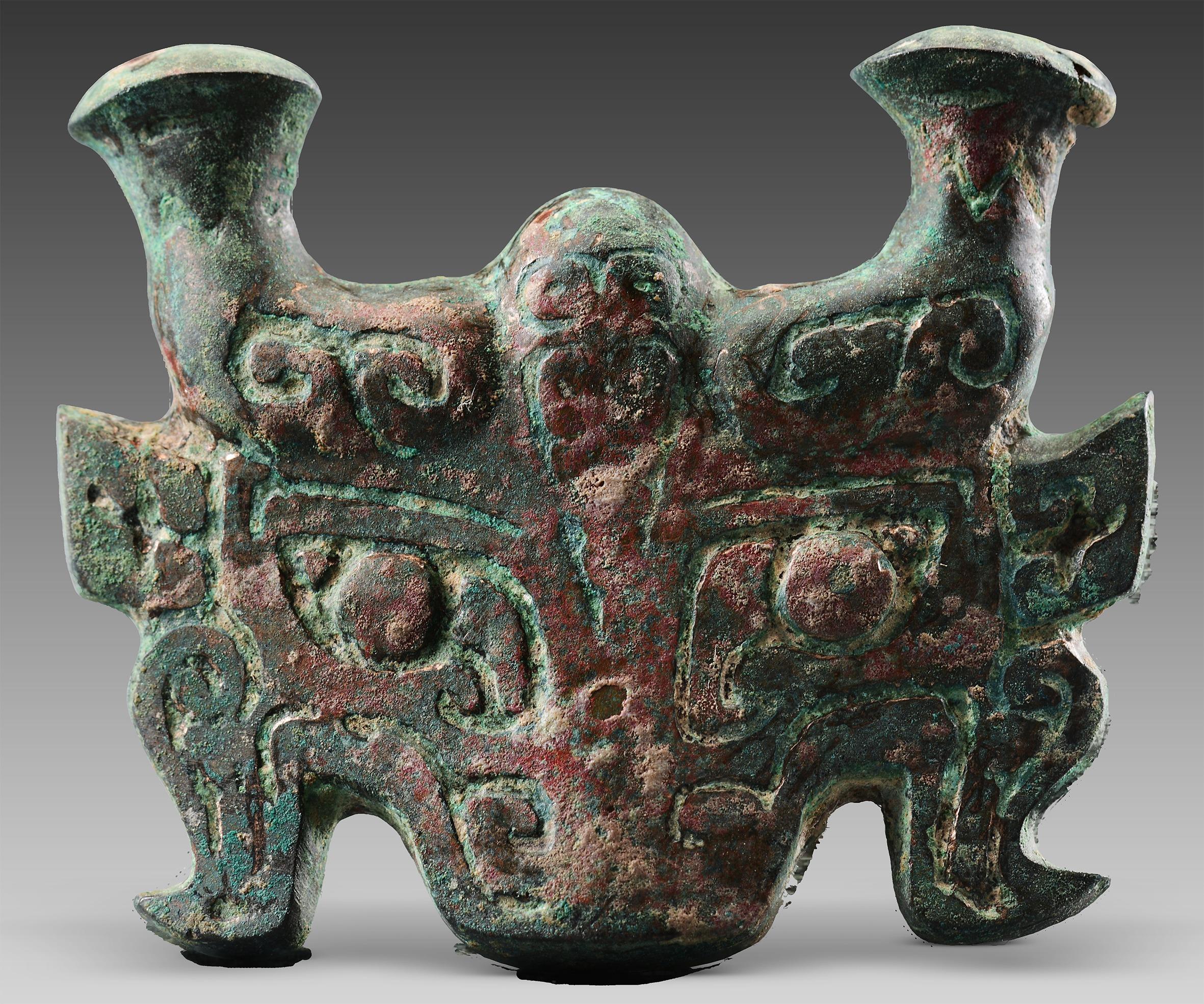 A bronze component of a carriage in the shape of a beast face discovered in tombs of the Zhaigou site, Qingjian county, Yulin, Shaanxi province. (PHOTO PROVIDED TO CHINA DAILY)
A bronze component of a carriage in the shape of a beast face discovered in tombs of the Zhaigou site, Qingjian county, Yulin, Shaanxi province. (PHOTO PROVIDED TO CHINA DAILY)
Since the 1940s, scattered bronzeware has been accidentally discovered in a dozen counties on the Shanxi-Shaanxi Plateau by local people on a number of occasions. Although they sent the artifacts to local museums, archaeological researchers found it difficult to ascertain detailed background information, such as where exactly they were found, how they were discovered and whether or not they were in close proximity when discovered and retrieved.
But questions surrounding them may soon be answered.
This is due to the recent excavation at the Zhaigou site in Qingjian county, Yulin city, Shaanxi province. It has revealed the largest Shang Dynasty (c. 16th century-11th century BC) site with the richest remnants yet found on the Shanxi-Shaanxi Plateau.
The site has tombs of the late Shang period, the largest in scale and number on the plateau, and those buried in the tombs enjoyed the highest status, of all the Shang tombs excavated so far in the region, according to a news conference by the National Cultural Heritage Administration on May 30 in Beijing.
Other breakthroughs made in Shang archaeology in the northern part of China were also announced.
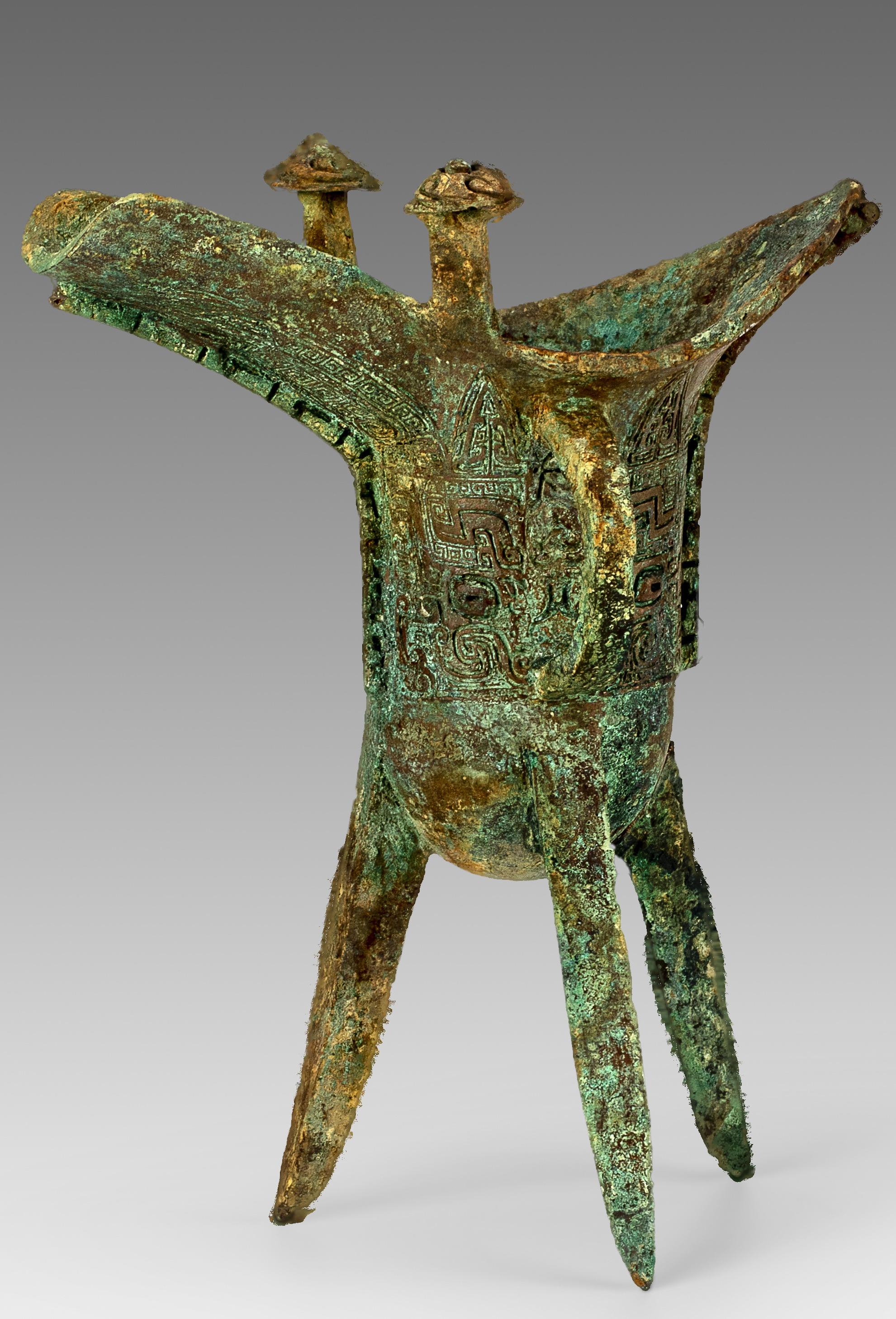 A bronze drinking vessel unearthed from Zhoujiazhuang site in Shijiazhuang, Hebei province. (PHOTO PROVIDED TO CHINA DAILY)
A bronze drinking vessel unearthed from Zhoujiazhuang site in Shijiazhuang, Hebei province. (PHOTO PROVIDED TO CHINA DAILY)
The latest study shows the Zhaigou site mainly dates to the late period of the Shang Dynasty, and covers an area of 3 million square meters. With a large-scale rammed earth works construction at the center, archaeologists have found areas for different functions like handicraft workshops and tombs on 11 hills surrounding the center area.
"All of the basic elements of a central settlement have been discovered at the site," says Xu Lianggao, a researcher with the Institute of Archaeology, which is part of the Chinese Academy of Social Sciences. "We found some tombs and large-scale structures in this area in the past, but this time the complete face of a settlement has been unveiled."
Nine high-level aristocratic tombs were found at the site, among which seven are rectangular tombs with tomb passages, which means they probably belong to leaders of various groups, says Sun Zhanwei, a researcher at the Shaanxi Academy of Archaeology.
"Tomb passages symbolize a high social status. For example, kings of the Shang Dynasty had four tomb passages. Some people inferior in rank to them, maybe members of the royal family, had two. In this hierarchy, those without a high status could not have a tomb passage," he explains.
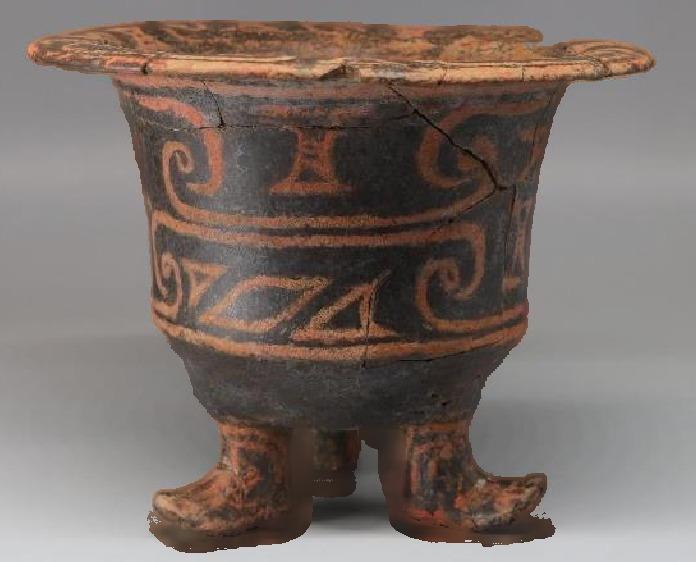 An exquisite painted pottery vessel with three boot-shaped feet found at the Xingong site in Beijing, which witnessed cultural communication in the Bronze Age. (PHOTO PROVIDED TO CHINA DAILY)
An exquisite painted pottery vessel with three boot-shaped feet found at the Xingong site in Beijing, which witnessed cultural communication in the Bronze Age. (PHOTO PROVIDED TO CHINA DAILY)
According to Sun, during the late Shang period, many local states appeared surrounding the central regime, with its central area located in Henan province. They had been conquered by Shang and then coexisted with the central regime by presenting tribute to it or rising in rebellions against it. Jiaguwen, or oracle bone inscriptions, the earliest known Chinese writing, record that, in the west and north of the central regime, there were nearly 70 states, but the whereabouts of them remain a mystery.
Lei Xingshan, a professor at the Capital Normal University in Beijing, points out that a grand tomb with a tomb passage often belongs to king of a state, and "when we find a tomb of this type, it almost certainly means a state has been discovered as well".
From the tombs, a large number of exquisite bronzeware, jadeware, bone artifacts, lacquerware and tortoise shells were unearthed, and are similar to those found in the past from aristocratic tombs in the Yinxu Ruins, the site of the capital of the late Shang period.
It suggests this area had been in close communication with the central regime, and showed the strong influence exerted on this area by the regime, says Sun Hua, an archaeology professor at Peking University.
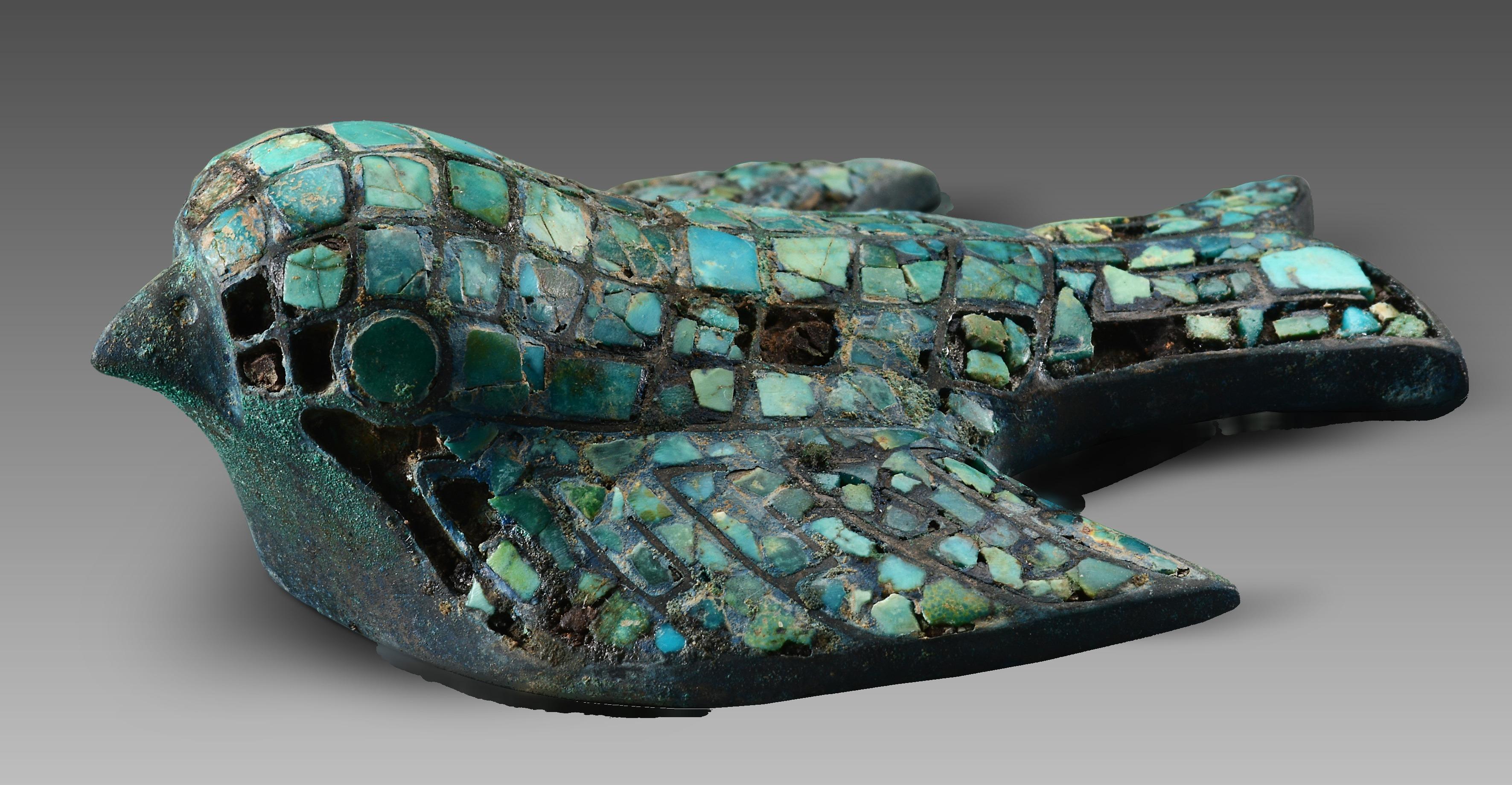 A bronze ornament in the shape of a bird decorated with turquoises found at the Zhaigou site. (PHOTO PROVIDED TO CHINA DAILY)
A bronze ornament in the shape of a bird decorated with turquoises found at the Zhaigou site. (PHOTO PROVIDED TO CHINA DAILY)
Better picture
In 1999, archaeologists discovered Huanbei Shang City, on the northern outskirts of Anyang, Henan province, and have carried out work at the ancient site.
Studies have shown that the city, located to the north of the Huanhe River, was probably a capital in the middle stage of the Shang Dynasty. It existed for about 50 to 60 years before it was destroyed in a mysterious fire and was abandoned. Then, constructions were built on the other side of the river now known as Yinxu Ruins, according to He Yuling, a researcher with the Institute of Archaeology, the Chinese Academy of Social Sciences, who has been engaged in the archaeological work on Huanbei Shang City.
Yinxu was the first independent excavation project carried out by Chinese academics almost a century ago, from which people discovered oracle bone inscriptions. It now holds a sacred place in the annals of China's archaeological history.
Last year, sacrificial pits and trenches surrounding the royal graves were discovered at Yinxu, enhancing people's understanding of Shang burial customs. Also last year, a new round of research started on the Huanbei Shang City, with the aim of gaining a better picture of its precise layout.
The biggest discovery this time, according to He, is that they identified moats, and two parts on the moats which obviously narrowed. This discovery could imply existence of passages through which people could go into and out of the city.
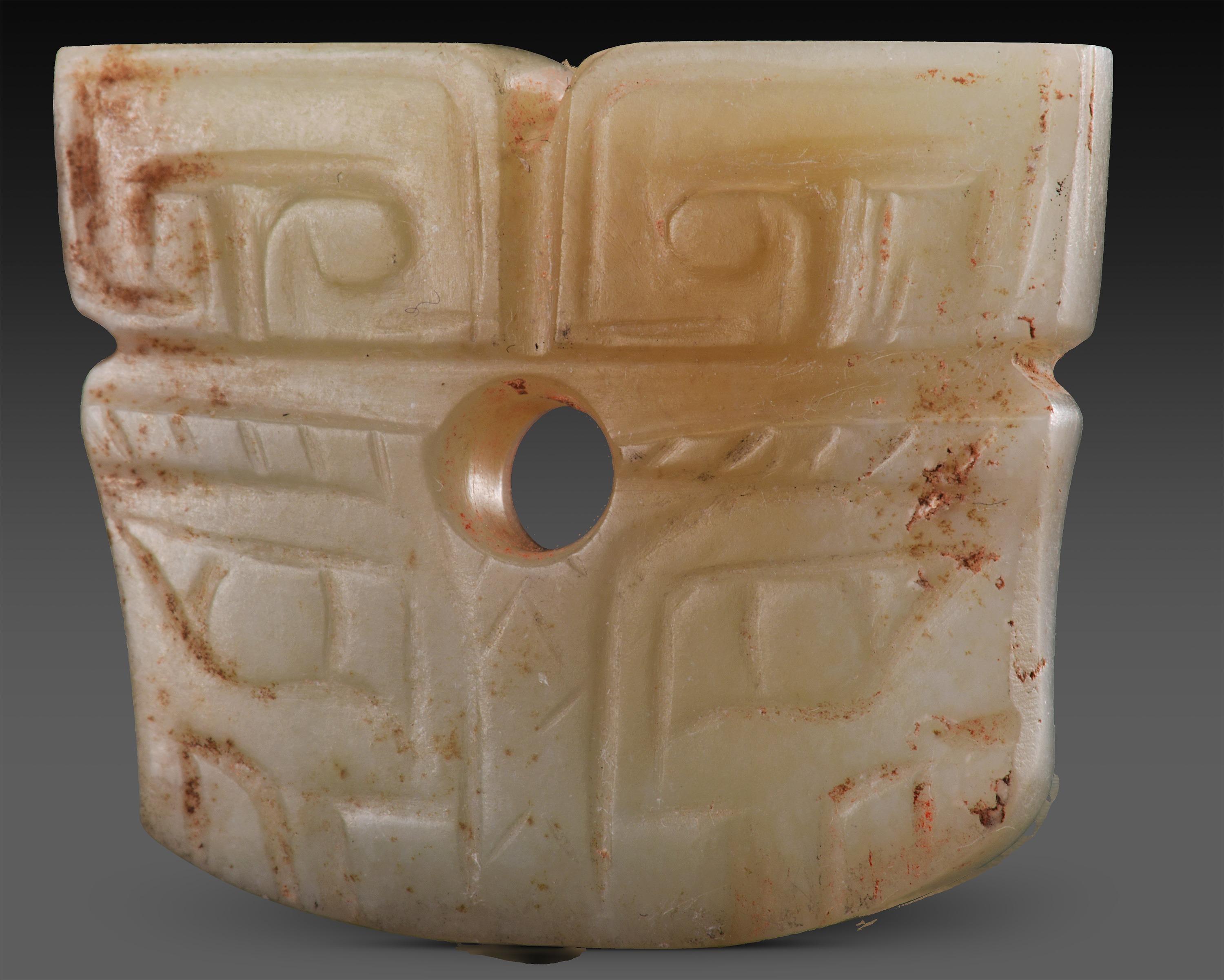 Jadeware with patterns of beast faces discovered in tombs of the Zhaigou site. (PHOTO PROVIDED TO CHINA DAILY)
Jadeware with patterns of beast faces discovered in tombs of the Zhaigou site. (PHOTO PROVIDED TO CHINA DAILY)
What they used to believe to be the foundation trench of the city walls was identified to actually be the city's moat.
Archaeological work shows Zhengzhou Shang City, an early Shang capital site in Zhengzhou, Henan, had city walls and moats.
Huanbei Shang City and some other middle Shang cities only had moats without city walls, and when it comes to the Yinxu Ruins, the late Shang capital, decadeslong archaeological excavations haven't found any city wall or moat. Maybe the need for moats and city walls lessened and their priority was reduced, says He.
He adds that city walls and moats were for defense, and came at a huge cost in terms of manpower and material resources.
When the Shang Dynasty was getting increasingly stronger, maybe it no longer needed such facilities.
However, Sun Hua points out the possibility that Yinxu had city walls or moats but the fact that we haven't found them yet does not mean they can be excluded.
"The research on Huanbei Shang City has made important progress, as part of our archaeological work on the Yinxu Ruins. It makes us see a society earlier than in Yinxu's time, a period which used to be very vague in our understanding. It fills many blanks in our study on the middle and late period of the Shang," says Wang Wei, director of the Chinese Academy of Social Sciences' Academic Division of History.
 A pair of golden earrings discovered in tombs of the Zhaigou site. (PHOTO PROVIDED TO CHINA DAILY)
A pair of golden earrings discovered in tombs of the Zhaigou site. (PHOTO PROVIDED TO CHINA DAILY)
Moreover, a surprise for their archaeological excavation is that they discovered a ditch of nearly 20 meters long for sacrifice, which they didn't find in archaeological surveys before excavation.
According to He, they discovered three complete human bones from the three-layered ditch, and cow, pig, horse and bird bones belonging to at least 17 animals. What remains unknown is who or what the ditch was used to worship.
The ditch dates from the late Shang period when Yinxu was an active population center. "We used to believe there were no remains of the Yinxu time at the Huanbei Shang City site," says He. "The ditch tells us after the city was abandoned, the area was still regarded as somewhere important for Shang people."
Xu says: "Discovery of the ditch enhances our understanding of the layout of Yinxu. From last year's new findings surrounding the royal graves at Yinxu to this new discovery, our knowledge of the Yinxu area in the middle and late Shang period continues to grow."
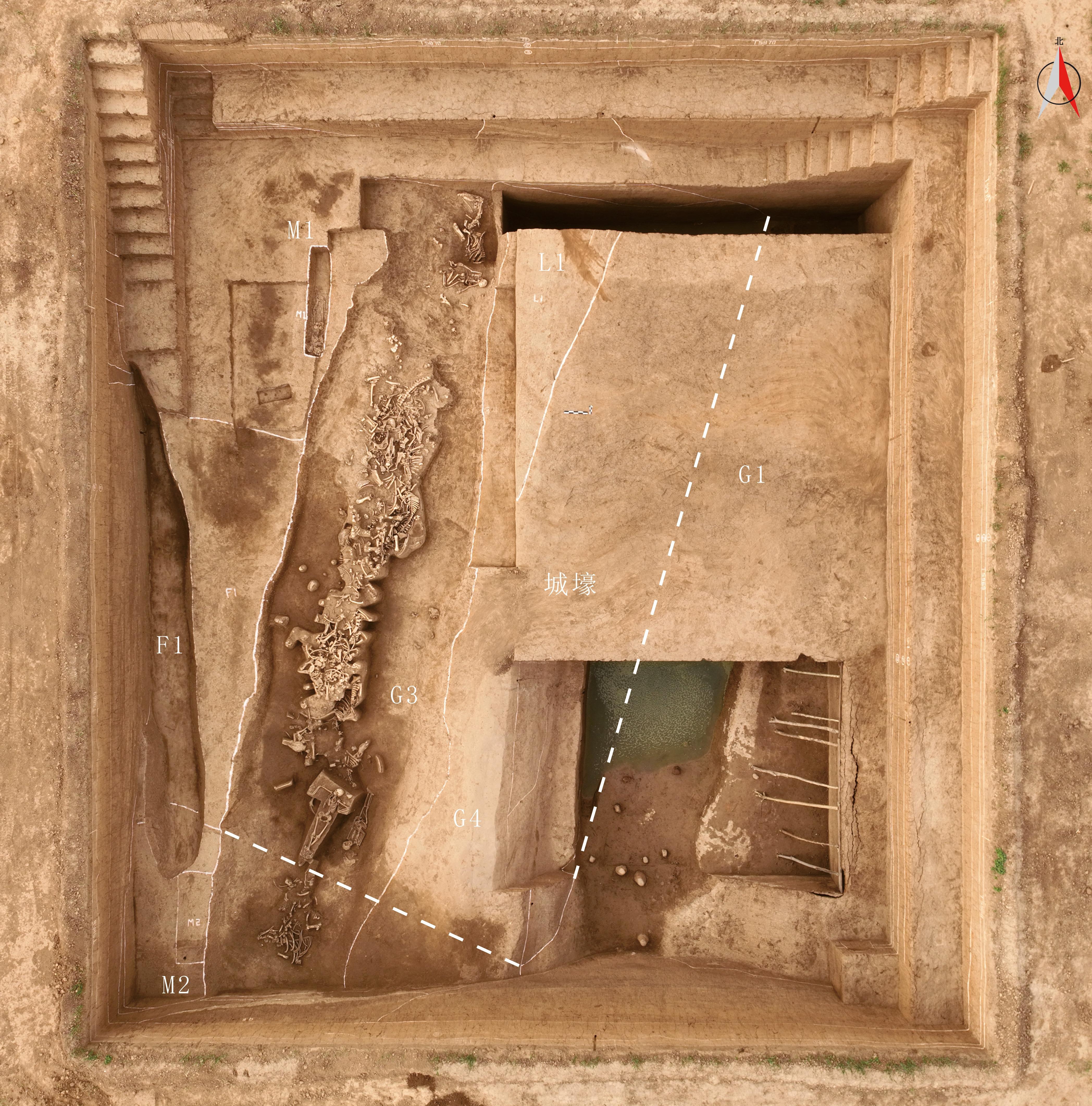 A corner of the Huanbei Shang City site in Anyang, Henan province. (PHOTO PROVIDED TO CHINA DAILY)
A corner of the Huanbei Shang City site in Anyang, Henan province. (PHOTO PROVIDED TO CHINA DAILY)
Multiple settlements
Some Shang sites, including settlements and tombs in Hebei province, were introduced as well at the conference. For example, from the Zhoujiazhuang site in Shijiazhuang which dates to the late stage of Shang, two grand tombs with tomb passages were discovered. This is the first time for archaeologists to find tombs of this type in Hebei, according to Wei Shuguang, a researcher at the Hebei Provincial Institute of Cultural Relics and Archaeology.
Hebei is very close to the central area of the Shang Dynasty, but scholars were not very clear about its cultural features in the Shang period before. The latest discoveries show that multiple settlements were located in this area. They provide a reference for us to understand the governance system of the Shang Dynasty, says Xu.
According to Lei, in the past, 77 grand graves with tomb passages of the Shang period were discovered at nine sites in three provinces (Henan, Shandong and Shanxi), among which 57 are in the Yinxu Ruins. But this time, another 10 are found in Hebei and Shaanxi, two new provinces, and they will bring us a clearer picture of the Shang states and the whole dynasty.
In Beijing's Fengtai district, the Xingong site, which is inferred to be a settlement dating to the Xia (c. 21st century-16th century BC) and Shang dynasties, was unveiled as well.
The latest study shows the site mainly dates to between 1500 BC and 1300 BC. The settlement is enclosed by two layers of moats. Inside the inner moat and between the two layers, there are ash pits and architectural remnants. Not far from the moats is a mass grave with 27 tombs.
A large number of artifacts have been unearthed from the tombs, showing the exalted status of the tomb owners, according to Han Hongye, a researcher at the Beijing Institute of Archaeology.
A highlight of the artifacts is a painted pottery vessel with three boot-shaped feet. "Even from a modern perspective, it is exquisite with true-to-life feet. Although we had discovered vessels with a similar shape in other sites before, we had rarely found such an exquisite one," says Han.
"Vessels with boot-shaped feet had been discovered from the Siwa Culture (a Bronze Age culture in Northwest China), while the painted patterns on the vessel were popular in the central area of the Shang Dynasty. From this vessel we can infer that cultural communication between different areas was going on in the early stage of the Shang Dynasty and even earlier," says Sun Hua.
According to Han, the Xingong site is one of the earliest Bronze Age settlements ever found in Beijing. The artifacts unearthed show features of local culture, culture of the central area and even the Eurasian grassland, vividly reflecting the communication and integration of cultures and people in the Bronze Age.
Contact the writer at wangru1@chinadaily.com.cn


